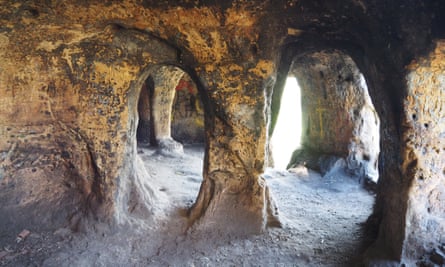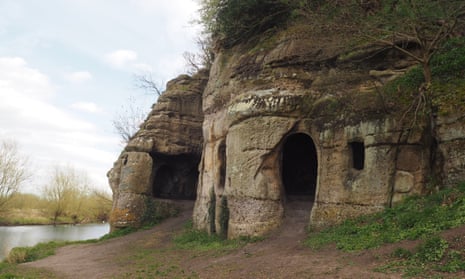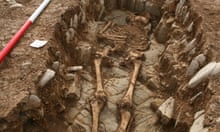A cave house previously thought to be an 18th-century folly has been identified as one of the oldest intact domestic interiors ever found in the UK and was once, archaeologists tantalisingly believe, the home of an exiled Anglo-Saxon king.
In the 18th century, Anchor Church cave in south Derbyshire was used by local gentry as a place for parties, and until now it was officially understood that that was as far back as its history went.
But archaeologists now believe the cave house can be dated to 1,200 years ago, probably lived in by Eardwulf who was deposed as king of Northumbria in AD806 and died in AD830.
Edmund Simons, the principal investigator on the project, grew up in an area surrounded by cave houses. “They are very difficult things to understand and date and I’ve been fascinated by them all my life,” he said. “I remember falling off one when I was three.”
He normally works abroad but with travel impossible over the last year he decided to “indulge myself and get together a project to work out what the hell what these things are”. The project is looking at 170 sites, but it is Anchor Church cave where “everything just fitted together in a way that it normally doesn’t happen with these things”, Simons said.
The cave house is Grade II listed as a natural cave enlarged in the 18th century. But that cannot be the case, said Simons. “It’s not a natural cave, I can’t think of a natural process that makes walls, doors and windows, let alone pillars.” Everything about the cave – the narrowness of the windows, for example – pointed to Saxon architecture.

One local legend links the site to Saint Hardulph, previously King Eardwulf, and Simons believes it is true. He is convinced that Eardwulf lived there as a hermit, where his enemies could keep an eye on him, in caves that were constructed or enlarged to house him.
The word “hermit” may conjure up images of a bearded, raggedy old man eating nuts and fruit alone. In reality, said Simons, “this is somebody who would have had disciples with him and would have been revered as holy, probably as a saint in his own lifetime. He doesn’t have his great feasting hall any more but it is quite a nice gaff.”
Hardulph was buried at Breedon on the Hill in Leicestershire, five miles from the caves.
The discovery makes it “probably the oldest intact domestic interior in the UK”, said Simons. “We have churches from this kind of date but we haven’t got anywhere where people slept and ate and prayed, all that kind of thing. Here, we’ve got one. It is quite remarkable.”
Simons said cave dwellings had often been overlooked by historians but they “may be the only intact domestic buildings to have survived from the Saxon period. This project has so far identified more than 20 other sites in the West Midlands that could date from as early as the fifth century.”
The team believe the caves were modified in the 18th century when it was recorded that Sir Robert Burdett “had it fitted up so that he and his friends could dine within its cool and romantic cells”. This included widening openings so that well-dressed ladies could pass through.
Simons led a team of archaeologists from the Royal Agricultural University (RAU) and Wessex Archaeology. The conclusions are documented in a study published in the Proceedings of the University of Bristol Speleological Society.










